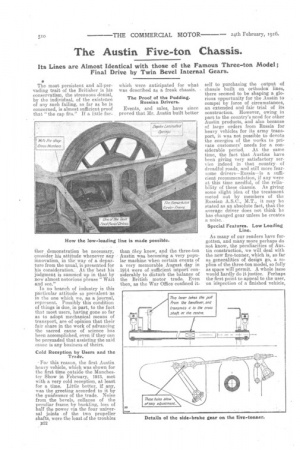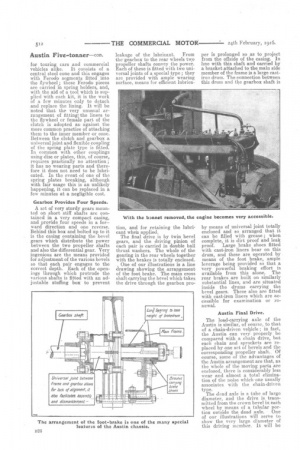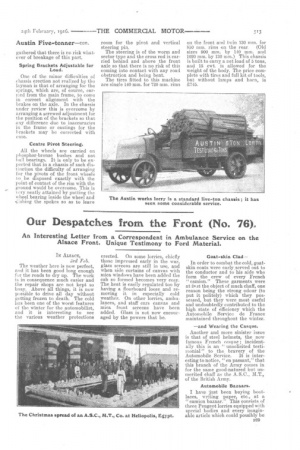The Austin Five-ton Chassis.
Page 4

Page 5

Page 6

Page 7

If you've noticed an error in this article please click here to report it so we can fix it.
Its Lines are Almost Identical with those of the Famous Three-ton Model ; Final Drive by Twin Bevel Internal Gears.
The most persistent and all-pervading trait of the Britisher is his conservatism, the strenuous denial, by the individual, of the existence of any such failing, so far as he is concerned, is almost sufficient proof that "the cap fits." If a little fur
flier demonstration be necessary, consider his attitude whenever any innovation, in theway of a departure from the usual, is presented for his consideration. At the best his judgment is summed up in that by now almost notorious phrase " Wait and see."
In no branch of industry is this particular attitude so prevalent as in the one which we, as a journal, represent. Possibly this condition of things is due, in part, to the fact that most users, having gone so far as to adopt mechanical means of transport, are of opinion that their fair share in the work of advancing the sacred cause of science has been accomplished, even if they can be persuaded that assisting the said cause is any business of theirs.
Cold Reception by Users and the Trade.
• For this reason, the first Austin heavy vehicle, which, was shown for the first time outside the Manchester Show in February, 1913, met with a very cold reception, at least for a time. Little better, if any, was the greeting accorded to it by the quidnunes of the trade. Noise from the bevels, collanse of the peculiar frame, by buckling, loss of half the power via the four universal joints of the two propeller shafts, were the least of the troubles than they knew, and the three-ton Austin was becoming a very popular machine when certain events of a very memorable August day in 1914 were of sufficient iniport considerablyto disturb the balance of the British motor trade. Even then, as the War Office confined it
self to purchasing the output of chassis built on orthodox lines, there seemed to be shaping a glorious opportunity for the Austin to compel by force of circumstances, an extended and fair trial of its construction. However, owing in part to the country's need for other Austin products, and also because of large orders from Russia for heavy vehicles for its army transport, it was not possible to devote the energies of the works to private customers' needs for a con siderable period. At the same time, the fact that Austins have been giving very satisfactory service indeed in that country. of dreadful roads, and still more fearsome drivers—Russia--is a sufficient recommendation, if any were at this time needful, of the reliability of these chassis. As giving some slight idea of the treatment meted out by members of the Russian A.S.C., M.T. it may be stated as an absolute fact, that the average driver does not think he has changed gear unless he creates a noise.
Special Features. Low Loading Line.
As many of our readers have forgotten, and many more perhaps do not know,. the peculiarities of Austin construction, we will deal with the nevi/ five-tonner, which is, so far as generalities of design go, a replica of the three-ton model, so fully as space will permit. A whole issue would hardly do it justice. Perhaps the first point to appeal to the user, on inspection of a finished vehicle,
is the low load line rendered possible. This, it should be explained, is owing to the special arrangement of the rear axle, which is carried between two pairs of semi-elliptic
springs, and, instead of being entirely below the frame, is taken through the centre of the side mem-' hers, these being extraordinarily deep, and perforated for the purpose. The result iS, of courSe, that instead of the fulldepth of frame, plus clearance, to allow of vertical movement being necessary from the top of the axle to the top of the frame, only a small portion of the frame, plus the same clearance, is needed.
Apparent Absence of Radiator.
The next feature to impress the observer is the unusual shape of the bonnet, and the apparent absence of radiator. The Austin Co. is the only British maker now using this arrangement, although it is fairly common on the Continent and in the -United States. The radiator is, as a matter of fact, bolted to the dash, and covered, so far as the front side is concerned, by the bonnet. The fan is placed in front of the cooler, and not behind. Considerable space could be devoted to a full dissertation on the special arrangement of bonnet and fastenings, made with a view to rendering the engine as accessible as possible. Our engine illustrations must serve to indicate this feature.
The Engine.
The engine itself is, as one might say, instinct with Austin features, ever unconventional, but always striving after the best, from all
points of view. The method of casting the cylinders, each of which is a separate piece, has been almost a hall-mark of Austin design for years, and although it has been departed from at least once, the company has returned to its old love in this respect.
It is 4i1 in. by 6 in. bore and stroke respectively. The valves are arranged in two lines, the induction being on the off side, and the exhausts on the near. Each individual valve, with its spring, washer, adjustable tappet, etc., is enclosed by an aluminium cover held in place by a spring clip, and therefore available for instant removal. The oiling is by pressure system, a pump at the bottom of
the crankcase feeding direct to the main bearings' the oil running thence through the drilled crankshaft to the brig-ends. The surplus lubricant is thrown on to the cylinder walls and gudgeon pins, and afterwards returns, via a filter, to the pump for re-circulation. An ample reservoir is provided by a tank on the bonnet boards, and readily available for filling and cleaning.
Carburetter. Dual Ignition, Radiator.
The carburetter is a special Austin model of' the Claudel-Hobson type.. The mixture passes' then tO a hot-water-jacketed induction piPe, which extends' the -full) length 'of the engine. Dual ignition is fitted, and this consists, of high-tension magneto for the one setaiv.1 an accumulator with coil for the other' a a common distributor is utilized for
both systems. As already mentioned, the radiator is placed behind the engine in the dashboard. It is af the honeycomb type, but specially :mounted so as to obviate any liability to damage owing to vibratioii. One of the principal obiections to this form of cooler, that it is liable to be dogged up with road dirt, does not, of course, apply' to the Austin owing to the sheltered position of this unit..
Clutch: Unusual Arrangement of Leather Lining.
The friction clutch on the Austin model provides us with another example of the ingenuity which is distinguishable in almost every detail of these remarkable vehicles. It is of the leather-lined cone type, but of a special design, and it bas prov:xl itself to be satisfactory both for touring cars and commercial
vehicles alike. It consists of a central steel cone and this engages with Ferodo segments fitted into the flywheel ; these Ferodo pieces are carried in spring holders, and, with the aid of a tool which is supplied with each kit, it is the work of a few minutes only to detach and replace the lining. It will be noted that the very unusual arrangement of flttingtthe liners to the flywheel or female part of the clutch is adopted as against the more common practice of attaching them to the inner member or cone. Between the clutch and gearbox a universal joint and flexible coupling of the spring plate type is fitted. In common with other couplings using disc or plates, this, of course, requires practically no attention ; it has no wearing parts and therefore it does not need to be lubricated. In the event of one of the spring plates breaking, although with fair usage this is an unlikely happening, it can be replaced in a few minutes at a negligible cost.
Gearbox Provides Four Speeds.
A set of very sturdy gears mounted on short stiff shafts are contained in a very compact casing, and provide four speeds in a for-ward direction and one reverse. Behind this box and bolted up to it is the casing containing the bevel gears which distribute the power between the two propeller shafts and also the differential gear. Very ingenious are the means provided for adjustment of the various bevels so that each pair engages to the correct depth. Each of the openings through which protrude the various shafts is fitted with an adjustable stuffing box to prevent leakage of the lubricant. From the-gearbox to the rear wheels tws, propeller shafts convey the power. Each of these is fitted with two universal joints of a special type ; they are provided with ample wearing surface, means for efficient lubrica
tion, and for retaining the lubricant when applied. The final drive is by twin bevel gears, and the driving pinion of each pair is carried in double ball thrust washers. The whole of the gearing in the rear wheels together with the brakes is totally enclosed.
One of our illustrations is a line drawing showing the arrangement of the foot brake. The main cross shalt carrying the bevel which takes the drive through the gearbox pro
per is prolonged so as to project from the offside of the easing. In line with this shaft and carried by a bracket attached to the main side member of the frame is a large castiron drum. The connection between this drum and the gearbox shaft is
by means of universal joint totally enclosed and so arranged that it can be filled with grease ; when complete, it is dirt proof and leak proof. Large brake shoes fitted with cast-iron liners bear on this drum, and these are operated by means of the foot brake, ample leverage being provided so that a very powerful braking effort is available from this alone. The rear brakes are built on similarly substantial lines, and are situated inside the drums carrying the bevel gears. These also are fitted with cast-iron liners which are accessible for examination or renewal.
Austin Final Drive.
The load-carrying axle of the Austin is similar, of course, to that of a chain-driven vehicle; in fact, the Austin can very, properly be compared with a chain drive, but each chain and sprockets are replaced by one set of bevels and the corresponding propeller shaft. Of course, some of the advantages of the Austin arrangement are that, as the whole of the moving parts .are enclosed, there is considerably less wear and almost a total elimination of the noise which one usually associates with the chain-driven type. The dead axle is a tube of large diameter, and the drive is transmitted from the crown bevel in each wheel by means of a tubular portion outside the dead axle. One of our illustrations will serve to show the very large diameter of this driving member. It will be gathered that there is no risk whatever of breakage of this part.
Spring Brackets Adjustable for Load, One of the minor difficulties of chassis erection not realized by the layman is that of arranging for the springs, which are, of course, carried from the main frame, to come in correct alignment with the brakes on the axle. In the chassis under review this is overcome by arranging a screwed adjustment for the position of the brackets so that any difference due to inaccuracies in the frame or castings for the brackets may be corrected with ease.
Centre Pivot Steering.
All the wheels are carried on phosphor-bronze bushes and not hall bearings. It is only to be expected that in a chassis of such distinction the difficulty of arranging for the _pivots of the front wheels o be disposed exactly with the point of contact of the rim with the ground would be overcome. This is very neatly attained by putting the wheel bearing inside the wheel and 'dishing the spokes so as to leave room for the pivot and vertical steering pm.
The steering is of the worm and sector type and the cross rod is carried behind and above the front axle so that there is no risk of this coming into contact with any road obstruction and being bent. The tires fitted to this machine are single 140 cam. for 720 mm. rims on the front and twin 130 mm. for 850 mm, rims on the rear. (Old sizes 900 mni. by 140 mm. and 1020 mm. by 130 m m.) This chassis is built to carry a net load of 5 tons, and 15 cwt. is allowed for the weight of the body. The price complete with tires and full kit of tools, but without lamps and horn, is £745.




















